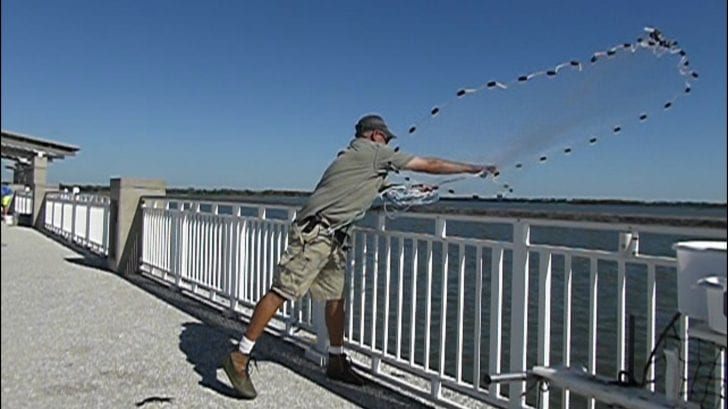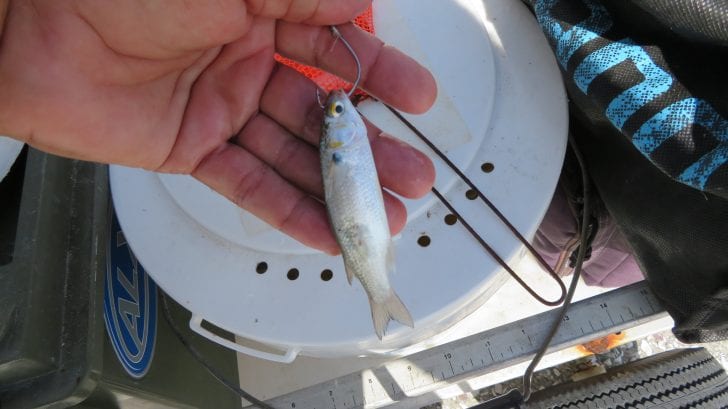I t is that time of year when most experienced anglers keep a cast net with their fishing tackle. After all, a cast net can be one of the only means to catch certain live baits in the Lowcountry.
Shrimp, Menhaden, and especially, Finger Mullet, are amongst the top choices for throwing one of these nets—Finger Mullet sitting at the top of the list.
As we move from July into August, Finger Mullet have reached just the right size to get caught in 3/8-inch cast nets easily.
They will usually be found in large and small schools moving about the small creeks in the Charleston Harbor, and of course, the local rivers, like the Ashley River, the Wando and the Cooper, etc.
With these schools of Finger Mullet on the move, make them an easy diet for Flounder, Spotted Seatrout, Red Drum, Spanish Mackerel, Cobia, Pompano, Jack Crevalle, Black Sea Bass, and so on.
Hooked through the nose and kept alive on different sized Carolina rigs, make this fish a great choice for bait.
Let me explain that using a cast net is not as easy as it sounds
A lot of bait shops will sell frozen, dead Finger Mullet for bait, but live Finger Mullet are not easy to keep alive for long periods of time. Therefore, it is usually a daily chore when fishing to catch them fresh with a cast net.
Let me explain that using a cast net is not as easy as it sounds, and if learned correctly, comes with a great amount of responsibility.
First, the larger the cast net, usually the more bait you can catch in a single throw, but that’s not always the case in some circumstances.
There are things to consider when deciding whether you can throw a large cast net like a 7-footer or larger. When I say a 7-footer, just remember that a 7-foot cast net will expand to 14-feet.
The things that you would need to consider would be the location you are targeting your bait
The things that you would need to consider would be the location you are targeting your bait, either small creeks that are narrow or whether you are throwing off a boat in open water or off of low piers or docks, targeting schools as they pass by or swim alongside.
It also helps a great deal if you familiarize yourself with the debris and environment you are throwing in.
Keep your eye out for rocks and structure, poles and metal, things that may tangle your net up and tear it apart or get it stuck under water for good.
Whereas in a lot of cases individuals throw the rope in the water and leave the net to Mother Nature, and that is not acceptable.
Taking these precautions will not only help you save your hard-earned money that you spent on equipment but will help the environment greatly.
If you realize that the location you have decided to hunt for bait in is full of debris, then I would recommend throwing a smaller net. A perfect size is usually 4- to 6-feet.
Throwing this size net will add to your speed and accuracy and reduce the chance of getting caught in debris.
After all, there are some spots that you throw in that a 12-foot across net would end up hung up on either side.
The other things to consider when throwing a cast net is how high you are throwing from, is the net’s weight heavy enough to sink at a faster speed to trap the bait, and will the net throw against the wind easily?
Just remember large nets catch a lot of wind, making it difficult to throw further distances. The wind will push the net and stall it in the air and a lot of times your bait will outrun you.
Whereas throwing a smaller net will catch less wind, throw out further and faster and more accurate, successfully catching a good number of Finger Mullet.
If you manage in a short period of time to successfully throw 3 or 4 times, you will easily have enough bait for a 5-gallon bucket aerated.
It is imperative that we try to refrain from losing or leaving cast nets in our waters
I would recommend trying not to exceed 3 dozen live Finger Mullet in a 5-gallon bucket. Finger Mullet run out of oxygen easily, and if you try to overfill your live well with bait, they will surely start to die by lack of oxygen.
As for the responsibility that each fisherman has when using cast nets anywhere in our waterways, it is imperative that we try to refrain from losing or leaving cast nets in our waters due to misuse or accidents.
We must try with all effort, if a net is caught on debris, to pull the net out regardless of whether the net tears apart or not. Why? Some may wonder.
Most cast nets are made of monofilament, and monofilament takes a long long time to break down. Monofilament is also in most cases transparent and in our darker waters cannot be seen easily, especially by marine life.
When these nets are left in our rivers and under our piers, especially at the Mount Pleasant Pier.
There a large amount of steel rebar was left behind under and all around its structure, creating an unnatural environment, which has become more like a dam to the constantly moving rivers where each bar of steel is catching debris on the ingoing and outgoing tides.
Individuals losing cast nets in this debris and leaving their nets is creating a dangerous, hostile environment for all kinds of marine life.
As the fish and animals move about feeding and following the currents, they blindly swim into these abandoned or caught nets, getting trapped and dying.
If we as individuals do not protect our environment and participate in conservation, then who will?
Enjoy yourself, learn how to use a cast net if you can, and have a great time catching your own bait, and please remember that there is a great amount of responsibility that a lot of us have not thought about.
I hope this information helps you with your next fishing adventure. Until next time, and like I always say, good luck out there and have fun fishing!
To view some fishing adventures, go to my “Fishing with Jiggin Jerry” Channel on YouTube or go to www.jigginjerry.net.
You may also enjoy reading The Destruction of the Mt. Pleasant Pier





